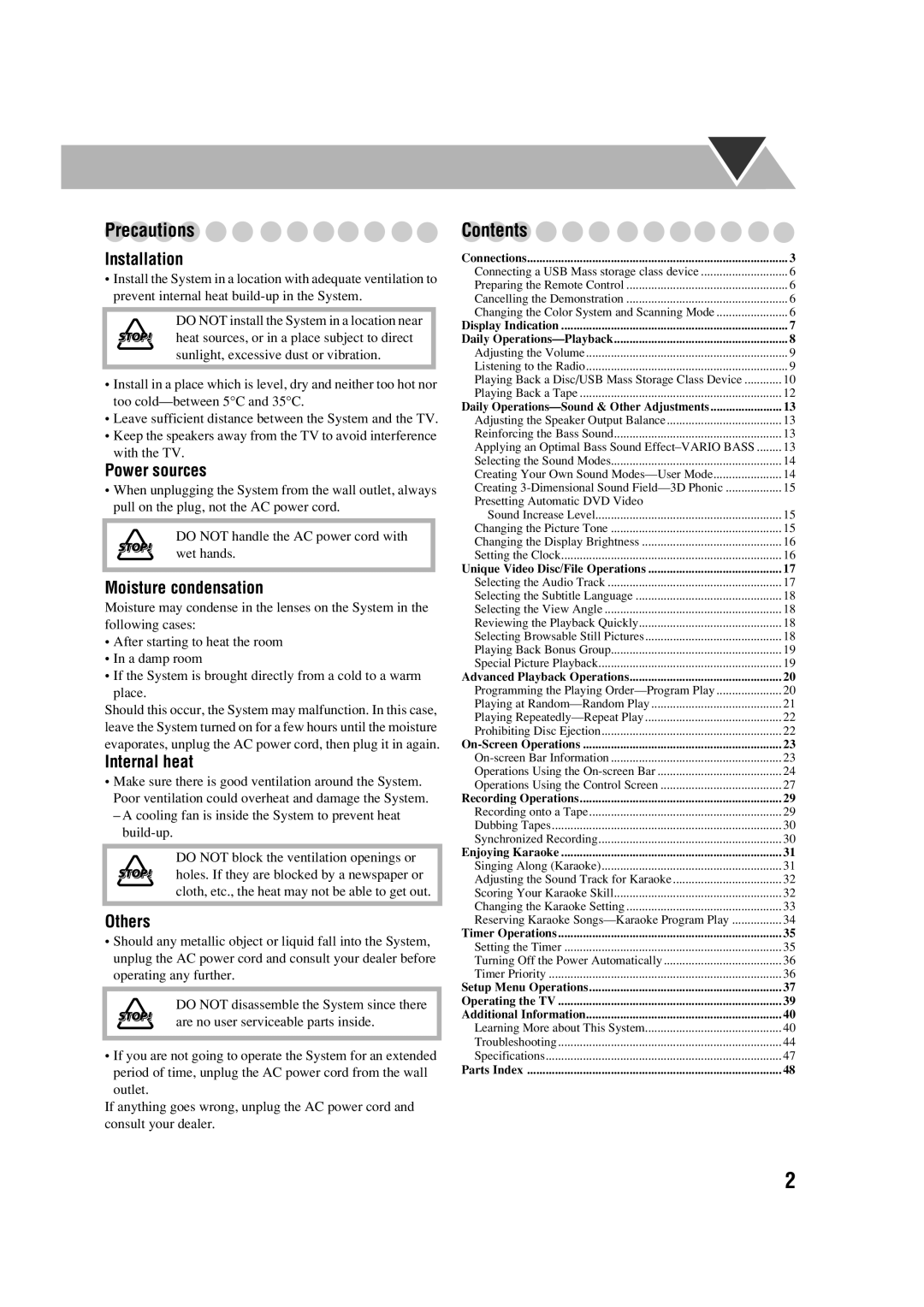
Precautions
Installation
•Install the System in a location with adequate ventilation to prevent internal heat
DO NOT install the System in a location near heat sources, or in a place subject to direct sunlight, excessive dust or vibration.
•Install in a place which is level, dry and neither too hot nor too
•Leave sufficient distance between the System and the TV.
•Keep the speakers away from the TV to avoid interference with the TV.
Power sources
•When unplugging the System from the wall outlet, always pull on the plug, not the AC power cord.
DO NOT handle the AC power cord with wet hands.
Moisture condensation
Moisture may condense in the lenses on the System in the following cases:
•After starting to heat the room
•In a damp room
•If the System is brought directly from a cold to a warm
place.
Should this occur, the System may malfunction. In this case, leave the System turned on for a few hours until the moisture evaporates, unplug the AC power cord, then plug it in again.
Internal heat
•Make sure there is good ventilation around the System. Poor ventilation could overheat and damage the System.
–A cooling fan is inside the System to prevent heat
DO NOT block the ventilation openings or holes. If they are blocked by a newspaper or cloth, etc., the heat may not be able to get out.
Others
•Should any metallic object or liquid fall into the System, unplug the AC power cord and consult your dealer before operating any further.
DO NOT disassemble the System since there are no user serviceable parts inside.
•If you are not going to operate the System for an extended period of time, unplug the AC power cord from the wall outlet.
If anything goes wrong, unplug the AC power cord and consult your dealer.
Contents |
|
Connections | 3 |
Connecting a USB Mass storage class device | 6 |
Preparing the Remote Control | 6 |
Cancelling the Demonstration | 6 |
Changing the Color System and Scanning Mode | 6 |
Display Indication | 7 |
Daily | 8 |
Adjusting the Volume | 9 |
Listening to the Radio | 9 |
Playing Back a Disc/USB Mass Storage Class Device | 10 |
Playing Back a Tape | 12 |
Daily | 13 |
Adjusting the Speaker Output Balance | 13 |
Reinforcing the Bass Sound | 13 |
Applying an Optimal Bass Sound | 13 |
Selecting the Sound Modes | 14 |
Creating Your Own Sound | 14 |
Creating | 15 |
Presetting Automatic DVD Video |
|
Sound Increase Level | 15 |
Changing the Picture Tone | 15 |
Changing the Display Brightness | 16 |
Setting the Clock | 16 |
Unique Video Disc/File Operations | 17 |
Selecting the Audio Track | 17 |
Selecting the Subtitle Language | 18 |
Selecting the View Angle | 18 |
Reviewing the Playback Quickly | 18 |
Selecting Browsable Still Pictures | 18 |
Playing Back Bonus Group | 19 |
Special Picture Playback | 19 |
Advanced Playback Operations | 20 |
Programming the Playing | 20 |
Playing at | 21 |
Playing | 22 |
Prohibiting Disc Ejection | 22 |
23 | |
23 | |
Operations Using the | 24 |
Operations Using the Control Screen | 27 |
Recording Operations | 29 |
Recording onto a Tape | 29 |
Dubbing Tapes | 30 |
Synchronized Recording | 30 |
Enjoying Karaoke | 31 |
Singing Along (Karaoke) | 31 |
Adjusting the Sound Track for Karaoke | 32 |
Scoring Your Karaoke Skill | 32 |
Changing the Karaoke Setting | 33 |
Reserving Karaoke | 34 |
Timer Operations | 35 |
Setting the Timer | 35 |
Turning Off the Power Automatically | 36 |
Timer Priority | 36 |
Setup Menu Operations | 37 |
Operating the TV | 39 |
Additional Information | 40 |
Learning More about This System | 40 |
Troubleshooting | 44 |
Specifications | 47 |
Parts Index | 48 |
2
